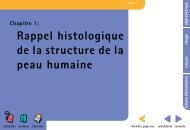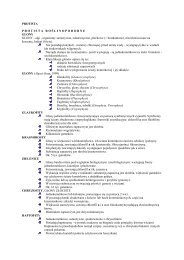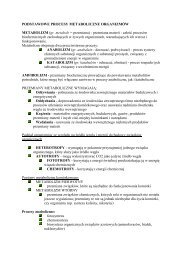Hair Shaft Abnormalities – Clues to Diagnosis and Treatment
Hair Shaft Abnormalities – Clues to Diagnosis and Treatment
Hair Shaft Abnormalities – Clues to Diagnosis and Treatment
You also want an ePaper? Increase the reach of your titles
YUMPU automatically turns print PDFs into web optimized ePapers that Google loves.
70<br />
References<br />
1 Lindelöf B, Forslind B, Hedblad MA, Kaveus<br />
U: Human hair form: Morphology revealed by<br />
light <strong>and</strong> scanning electron microscopy <strong>and</strong><br />
computer aided three-dimensional reconstruction.<br />
Arch Derma<strong>to</strong>l 1988; 124: 1359<strong>–</strong>1363.<br />
2 Nissimov J, Elchalal U: Scalp hair diameter<br />
increases during pregnancy. Clin Exp Derma<strong>to</strong>l<br />
2003; 28: 525<strong>–</strong>530.<br />
3 Happle R, König A: Familial naevus sebaceus<br />
may be explained by paradominant transmission.<br />
Br J Derma<strong>to</strong>l 1999; 144: 377.<br />
4 Happle R: Genetic hair loss. Clin Derma<strong>to</strong>l<br />
2001; 19: 121<strong>–</strong>128.<br />
5 Itin PH: Embryologie der Haut; in Traupe H,<br />
Hamm H (eds): Pädiatrische Derma<strong>to</strong>logie.<br />
Berlin, Springer, 1999, pp 1<strong>–</strong>9.<br />
6 Powell BC, Rogers GE: The role of keratin proteins<br />
<strong>and</strong> their genes in the growth, structure<br />
<strong>and</strong> properties of hair; in Jollès P, Zahn H,<br />
Höcker H (eds): Formation <strong>and</strong> structure of<br />
human hair. Basel, Birkhäuser, 1997, pp 59<strong>–</strong><br />
148.<br />
7 Jollès P, Zahn H, Höcker H (eds): Formation<br />
<strong>and</strong> Structure of Human <strong>Hair</strong>. Basel, Birkhäuser,<br />
1997, pp 59<strong>–</strong>148 .<br />
8 Emonet N, Michaille JJ, Dhouailly D: Isolation<br />
<strong>and</strong> characterization of genomic clones of<br />
human sequences presumably coding for hair<br />
cysteine-rich proteins. J Derma<strong>to</strong>l Sci 1997; 14:<br />
1<strong>–</strong>11.<br />
9 Itin PH, Sarasin A, Pittelkow MR: Trichothiodystrophy:<br />
Update on the sulfur-defi cient brittle<br />
hair syndromes. J Am Acad Derma<strong>to</strong>l 2001;<br />
44: 891<strong>–</strong>920.<br />
10 Silengo M, Valenzise M, Sorasio L, Ferrero<br />
GB: <strong>Hair</strong> as a diagnostic <strong>to</strong>ol in dysmorphology.<br />
Clin Genet 2002; 62: 270<strong>–</strong>272.<br />
11 Itin P: KID syndrome; in Schachner LA, Hansen<br />
RC: Pediatric Derma<strong>to</strong>logy. Edinbourgh,<br />
Mosby, 2003, pp 416<strong>–</strong>418.<br />
12 Itin PH, Fistarol SK: Ec<strong>to</strong>dermal dysplasias.<br />
Am J Med Genet 2004; 131C:45<strong>–</strong>51.<br />
13 Selvaag E, Aas AM, Heide S: Structural hair<br />
shaft abnormalities in hypomelanosis of I<strong>to</strong><br />
<strong>and</strong> other ec<strong>to</strong>dermal dysplasias. Acta Paediatr<br />
2000; 89: 610<strong>–</strong>612.<br />
14 Gilgenkrantz S, Blanchet-Bardon C, Nazzaro<br />
V, Mujica P, Alembik Y: Hypohidrotic ec<strong>to</strong>dermal<br />
dysplasia: Clinical study of a family of<br />
30 over three generations. Hum Genet 1989;<br />
81: 120<strong>–</strong>122.<br />
15 Rogers M: The ‘bar code phenomenon’: A microscopic<br />
artifact seen in patients with hypohidrotic<br />
ec<strong>to</strong>dermal dysplasia. Pediatr Derma<strong>to</strong>l<br />
2000; 17: 329<strong>–</strong>330.<br />
16 Kere J, Srivastava AK, Mon<strong>to</strong>nen O, Zonana<br />
J, Thomas N, Ferguson B, Munoz F, Morgan<br />
D, Clarke A, Baybayan P, Chen EY, Ezer S,<br />
Saarialho-Kere U, De la Chapelle A, Schlessinger<br />
D: X-linked anhidrotic (hypohidrotic)<br />
ec<strong>to</strong>dermal dysplasia is caused by mutation in<br />
a novel transmembrane protein. Nat Genet<br />
1996; 13: 409<strong>–</strong>416.<br />
Derma<strong>to</strong>logy 2005;211:63<strong>–</strong>71<br />
17 Monreal AWM, Ferguson BM, Headon DJ,<br />
Street SL, Overbeek PA, Zonana J: Mutations<br />
in the human homologue of mouse dl cause<br />
au<strong>to</strong>somal recessive <strong>and</strong> dominant hypohidrotic<br />
ec<strong>to</strong>dermal dysplasia. Nat Genet 1999;<br />
22: 366<strong>–</strong>369.<br />
18 Fosko SW, Stenn KS, Bolognia JL: Ec<strong>to</strong>dermal<br />
dysplasias associated with clefting: Signifi -<br />
cance of scalp dermatitis. J Am Acad Derma<strong>to</strong>l<br />
1992; 27: 249<strong>–</strong>256.<br />
19 Trüeb RM, Bruckner-Tuderman L, Wyss M,<br />
Widmer M, Wüthrich B, Burg G: Scalp dermatitis,<br />
distinctive hair abnormalities <strong>and</strong> a<strong>to</strong>pic<br />
disease in the ectrodactyly-ec<strong>to</strong>dermal dysplasia-clefting<br />
syndrome. Br J Derma<strong>to</strong>l 1995;<br />
132: 621<strong>–</strong>625.<br />
20 Trüeb RM, Tsambaos D, Spycher MA, Müller<br />
J, Burg G: Scarring folliculitis in the ectrodactyly-ec<strong>to</strong>dermal<br />
dysplasia-clefting syndrome:<br />
His<strong>to</strong>logic, scanning electron-microscopic <strong>and</strong><br />
biophysical studies of hair. Derma<strong>to</strong>logy 1997;<br />
194: 191<strong>–</strong>194.<br />
21 Wessagowit V, Mellerio JE, Pembroke AC,<br />
McGrath JA: Heterozygous germline missense<br />
mutation in the p63 gene underlying EEC syndrome.<br />
Clin Exp Derma<strong>to</strong>l 2000; 25: 441<strong>–</strong>443.<br />
22 Celli J, Duijf P, Hamel BCJ, Bamshad M,<br />
Kramer B, Smits APT, Newbury-Ecob R, Hennekam<br />
RCM, Van Buggenhout G, Van Haeringen<br />
A, Woods CG, Van Essen AJ, de Waal R,<br />
Vriend G, Haber DA, Yang A, McKeon F,<br />
Brunner HG, van Bokhoven H: Heterozygous<br />
germline mutations in the p53 homolog p63<br />
are the cause of EEC syndrome. Cell 1999; 99:<br />
143<strong>–</strong>153.<br />
23 Mills AA, Zheng B, Wang XJ, Vogel H, Roop<br />
DR, Bradley A: p63 is a p53 homologue required<br />
for limb <strong>and</strong> epidermal morphogenesis.<br />
Nature 1999; 398: 708<strong>–</strong>713.<br />
24 Mancini AJ, Paller AS: What syndrome is this?<br />
Ankyloblepharon-ec<strong>to</strong>dermal defects-cleft lip<br />
<strong>and</strong> palate (Hay-Wells) syndrome. Pediatr<br />
Derma<strong>to</strong>l 1997; 14: 403<strong>–</strong>405.<br />
25 Itin PH, Bühler U, Büchner SA, Guggenheim<br />
R: Pili trianguli et canaliculi: A distinctive hair<br />
shaft defect leading <strong>to</strong> uncombable hair. Derma<strong>to</strong>logy<br />
1993; 187: 296<strong>–</strong>298.<br />
26 Nakashima E, Mabuchi A, Kashimada K, Onishi<br />
T, Zhang J, Ohashi H, Nishimura G, Ikegawa<br />
S: RMRP mutations in Japanese patients<br />
with cartilage-hair hypoplasia. Am J Med Genet<br />
2003; 123: 253<strong>–</strong>256.<br />
27 Pruszkowski A, Bodemer C, Fraitag S, Teillac-<br />
Hamel D, Amoric JC, De Prost Y: Neonatal<br />
<strong>and</strong> infantile erythrodermas: A retrospective<br />
study of 51 patients. Arch Derma<strong>to</strong>l 2000; 136:<br />
875<strong>–</strong>880.<br />
28 Ansai S, Mitsuhashi Y, Sasaki K: Nether<strong>to</strong>n’s<br />
syndrome in siblings. Br J Derma<strong>to</strong>l 1999; 141:<br />
1097<strong>–</strong>1100.<br />
29 Powell J, Dawber RPR, Ferguson DJP,<br />
Griffi ths WAD: Nether<strong>to</strong>n’s syndrome: Increased<br />
likelihood of diagnosis by examining<br />
eyebrow hairs. Br J Derma<strong>to</strong>l 1999; 141: 544<strong>–</strong><br />
546.<br />
30 Chavanas S, Garner C, Bodemer C, Ali M,<br />
Hamel-Teilac D, Wilkinson J, Bonafé JL, Paradisi<br />
M, Kelsell DP, Ansai S, Mitsuhashi Y,<br />
Larrègue M, Leigh IM, Harper JI, Taïeb A, De<br />
Prost Y, Cardon LR, Hovnanian A: Localization<br />
of the Nether<strong>to</strong>n syndrome gene <strong>to</strong> chromosome<br />
5q32, by linkage analysis <strong>and</strong> homozygosity<br />
mapping. Am J Hum Genet 2000; 66:<br />
914<strong>–</strong>921.<br />
31 Chavanas S, Bodemer C, Rochat A, Hamel-<br />
Teillac D, Ali M, Irvine AD, Bonafé JL, Taïeb<br />
A, Barr<strong>and</strong>on Y, Harper JI, De Prost Y, Hovnanian<br />
A: Mutations in SPINK5, encoding a<br />
serine protease inhibi<strong>to</strong>r, cause Nether<strong>to</strong>n syndrome.<br />
Nat Genet 2000; 25: 141<strong>–</strong>142.<br />
32 Kleijer WJ, Beemer FA, Boom BW: Intermittent<br />
hair loss in a child with PIBI(D)S syndrome<br />
<strong>and</strong> trichothiodystrophy with defective<br />
DNA repair <strong>–</strong> Xeroderma pigmen<strong>to</strong>sum group<br />
D. Am J Med Genet 1994; 52: 227<strong>–</strong>230.<br />
33 Foulc P, Jumbou O, David A, Sarasin A,<br />
Stalder JF: Trichothiodystrophies: manifestations<br />
évolutives. Ann Derma<strong>to</strong>l Vénéréol<br />
1999; 126: 703<strong>–</strong>707.<br />
34 Venning V, Dawber RPR, Ferguson DJP, Kanan<br />
MW: Weathering of hair in trichothiodystrophy.<br />
Br J Derma<strong>to</strong>l 1986; 114: 591<strong>–</strong>595.<br />
35 Van Neste D: Dysplasies pilaires congénitales:<br />
conduite à tenir et intérêt de diverses méthodes<br />
de diagnostic. Ann Derma<strong>to</strong>l Vénéréol 1989;<br />
116: 251<strong>–</strong>263.<br />
36 Van Neste D, Houbion Y: Offi ce diagnosis of<br />
pathological changes of hair cuticular cell pattern;<br />
in Van Neste D, Lachapelle JM, An<strong>to</strong>ine<br />
JL (eds): Trends in Human <strong>Hair</strong> Growth <strong>and</strong><br />
Alopecia Research. Dordrecht, Kluwer Academic<br />
Publishers, 1989, pp 173<strong>–</strong>179.<br />
37 Brusasco A, Restano L: The typical ‘tiger-tail’<br />
pattern of the hair shaft in trichothiodystrophy<br />
may not be evident at birth. Arch Derma<strong>to</strong>l<br />
1997; 133: 249.<br />
38 Sarasin A, Blanchet-Bardon C, Renault G,<br />
Lehmann A, Arlett C, Dumez Y: Prenatal diagnosis<br />
in a subset of trichothiodystrophy patients<br />
defective in DNA repair. Br J Derma<strong>to</strong>l<br />
1992; 127: 485<strong>–</strong>491.<br />
39 De Berker D, Tolmie J, Dawber RPR: <strong>Hair</strong><br />
analysis in trichothiodystrophy <strong>to</strong> distinguish<br />
primary <strong>and</strong> secondary features. Br J Derma<strong>to</strong>l<br />
1991; 125(suppl 38):88.<br />
40 De Berker D: ‘Tiger tail’ pattern on polarized<br />
hair microscopic examination is found in<br />
healthy infants. Arch Derma<strong>to</strong>l 1997; 133:<br />
1313<strong>–</strong>1314.<br />
41 García-Hernández MJ, Moreno-Giménez JC,<br />
Camacho F: Acquired, partial trichothiodystrophy.<br />
Eur J Derma<strong>to</strong>l 1996; 6: 579<strong>–</strong>580.<br />
42 Sperling LC, Di Giovanna JJ: ‘Curly’ wood<br />
<strong>and</strong> tiger tails: An explanation for light <strong>and</strong><br />
dark b<strong>and</strong>ing with polarization in trichothiodystrophy.<br />
Arch Derma<strong>to</strong>l 2003; 139: 1189<strong>–</strong><br />
1192.<br />
Itin /Fistarol











